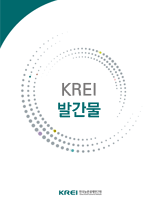요약문
This research is designed to analyze the effects of a Korea-U.S. FTA (Free Trade Agreement) on domestic agricultural sector and to suggest appropriate policies for the Korea-U.S. FTA to the Korean government. In addition, this study scrutinizes the FTAs that the United States negotiated with other countries.
To measure the effects of an FTA with the United States on domestic sector, a partial equilibrium model is used. Unlike partial equilibrium models that deal with imported goods as homogeneous goods, the United States products are dealt with as substitutes for domestic goods in this model. The cut in tariff caused by an FTA raises relative prices of domestic goods. Then, the demand for domestic goods decreases. Such effects can be measured with a cross-price elasticity of demand. If the substitutability of imported goods for domestic goods is high, the cross-price elasticity would be large.
In this research the effects of an FTA on commodity market in question is calculated in terms of the change in market size, not economic surplus. For livestock markets (beef, pork, chicken, and dairy products), the loss caused by removal of tariff varies from 540 billion won at minimum to 1 trillion won at maximum. The loss of domestic beef market is the largest and the pork market is followed.
In fruit industry the loss is measured for five fruits: apple, pear, grapes, peach, and mandarine orange. The total loss for five fruits changes from 280 billion won at minimum to 480 billion won at maximum. The losses of apple and grapes industry are large relative to other fruits.
For grains, the premium calculated as a price differential is used to measure the loss. The market size of the domestic grain industry would reduce by 510 billion won at minimum and 560 billion won at maximum. In particular, the soybean industry would be most affected because the difference in price between U.S. soybeans and domestic soybeans is relatively large.
Vegetables and specialty crops are little affected even after all kind of tariffs is lifted with a Korea-U.S. FTA. Vegetables (garlic, red pepper, onion, tomato, and strawberry), are so perishable that it is very costly to ship vegetables from the United States to Korea. Specialty crops, such as ginseng, have competitiveness in international market. The loss of vegetables and specialty crops varies from 99 billion won to 220 billion won.
The FTA negotiation with the United States can be composed of two parts: the plan for tariff cuts and the introduction of trade-related policy that relieves the trade shock. The focus in negotiation on tariff is how much to cut tariff and how long tariff of each commodity lasts. The gap between the requests that United States ask and the offer that Korea suggests is very large. It is not easy to reach an agreements in agricultural sector.
According to the survey on the FTAs that the United States negotiated, some features are found. First, the commodities that the United States farmers might lose were dealt with exceptions for tariff cuts. Second, the United States initiated an FTA negotiation with a strong strategies. Third, the most of FTA negotiations in agricultural sector were not equal to each country. For example, Australia opened its market more than the United States did in the U.S.-Australia FTA. Fourth, the United States allowed various types of tariff-reduction plan. Thus, Korea also needs to ask for the various types of tariff-cut schedule as other countries did.
The main issue on trade-relief measures is whether to introduce a safeguard in agricultural sector. It is also important, if a safeguard is introduced, which commodities to be applied, when it launches, how long it lasts if a safeguard is effective, and what measures to be used to relieve trade shocks. This research proposed that a safeguard should be introduced to products that large volume is imported, that tariff is already extremely high, and that large volume is likely imported if tariff is removed.
It is of great importance to introduce appropriate policies to relieve the shock caused by an FTA with the United States. The most basic tool is to raise the competitiveness of Korea's agricultural products. The competitiveness in market is evaluated in terms of price and quality. Because there are limits to enhance the price competitiveness through reducing production cost in Korea, the enhancement in competitiveness through quality improvement is getting more important. Furthermore, it is also an important marketing strategy to differentiate domestically-produced goods from imported goods with respect to safety.
In addition, various types of domestic policies are needed. First, it needs to sort farmers by size and types to raise the efficiency of policy. Second, it is necessary to create or find new market for agricultural products. A niche market is one of the examples. New markets increase demand for domestic agricultural products and improve farm household income.
저자에게 문의

저자소개
- 최세균
(Choi, Seikyun)
저자에게 문의

※ 퇴사하신 분이지만 아래의 내용을 입력해 주시면 관리자가 전달해드리겠습니다.
구매안내
KREI의 출판물은 판매 대행사 (정부간행물판매센터)와 아래 서점에서 구입 하실 수 있습니다.
판매대행사
- (주)정부간행물판매센터http://www.gpcbooks.co.kr사이트 바로가기
- 서울특별시 중구태평로 1가 25번지
- TEL 02) 394-0337, 734-6818
- FAX 02) 394-0339
판매서점


